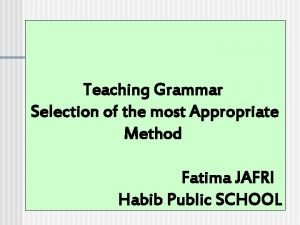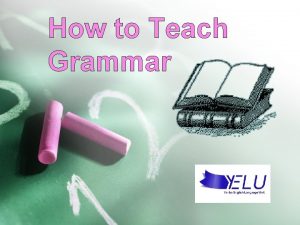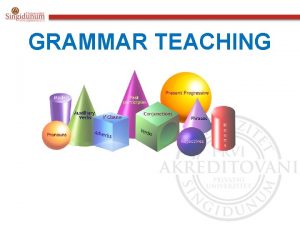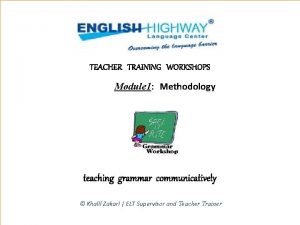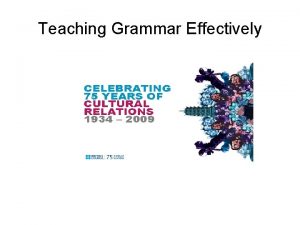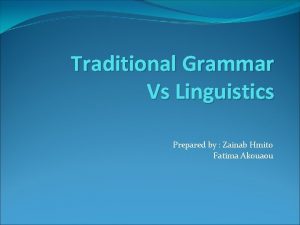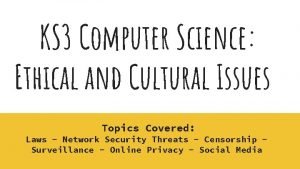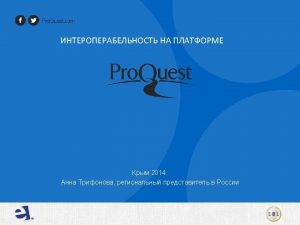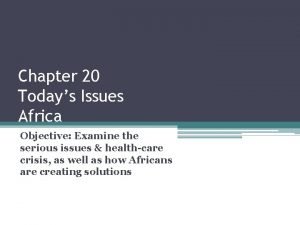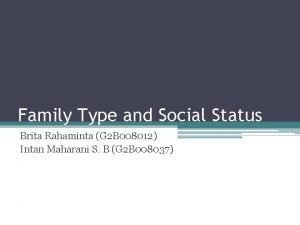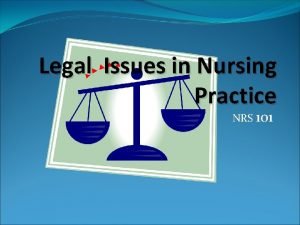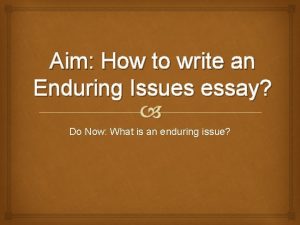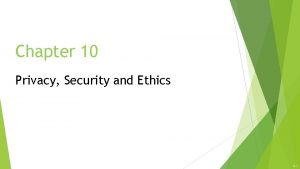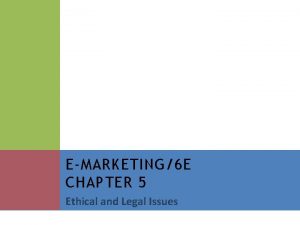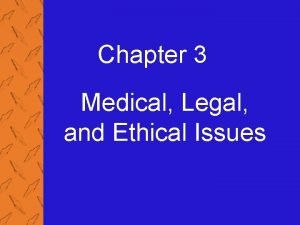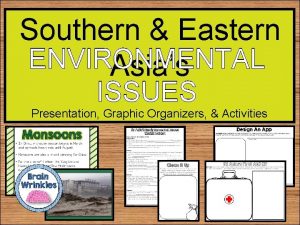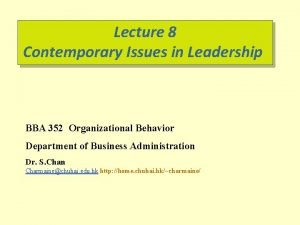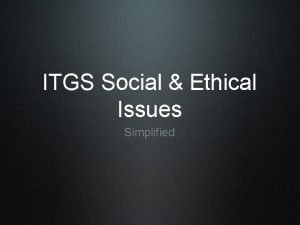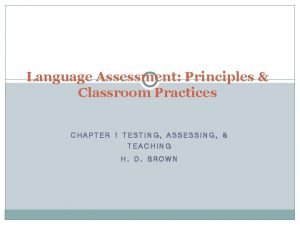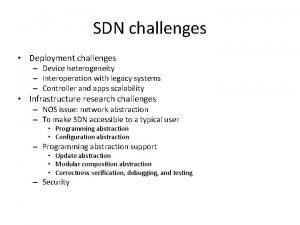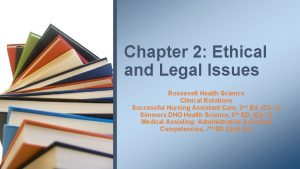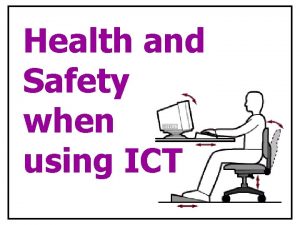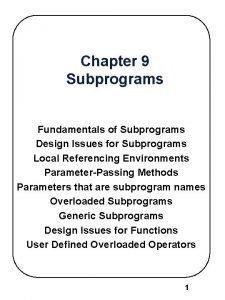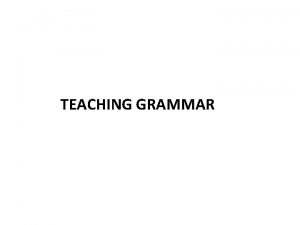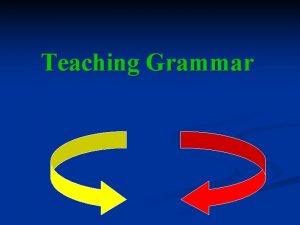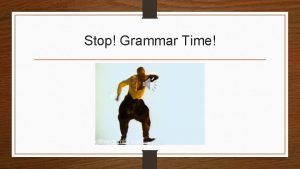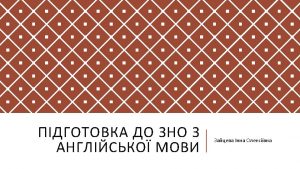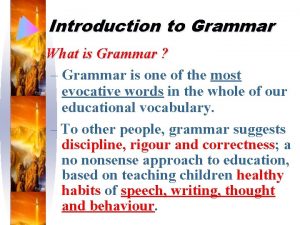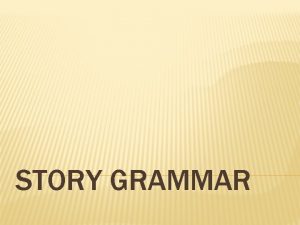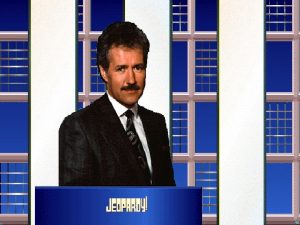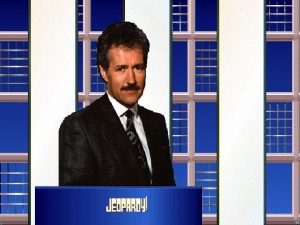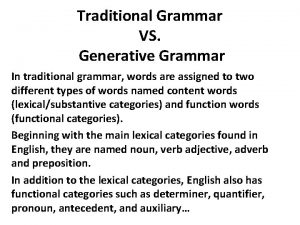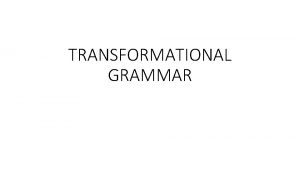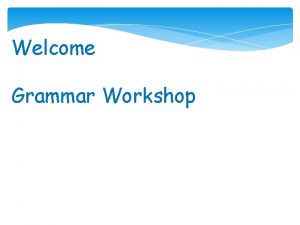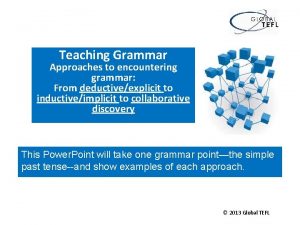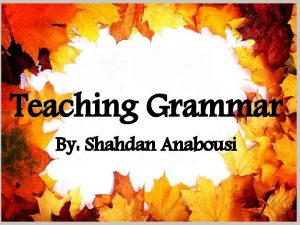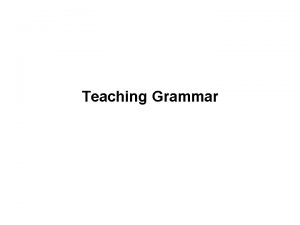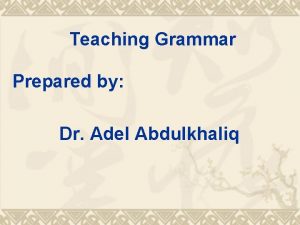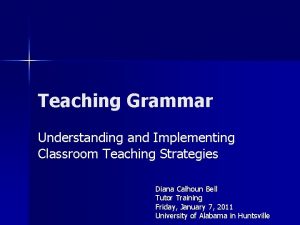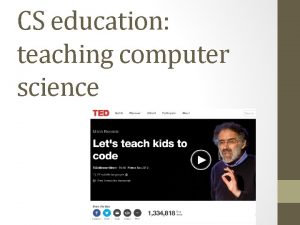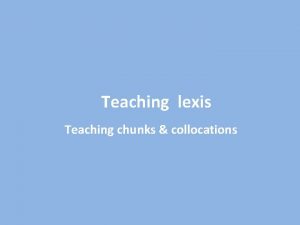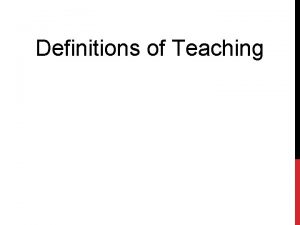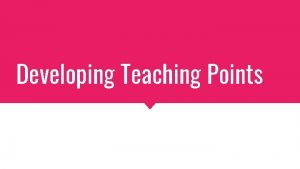GRAMMAR TEACHING What is GRAMMAR Issues in grammar


































- Slides: 34

GRAMMAR TEACHING

• What is GRAMMAR? • Issues in grammar teaching and learning • Does grammar teaching work or not? • GRAMMAR TEACHING CONCEPTS / APPROACHES • Should we teach grammar at all? • PROBLEMS WITH LEARNING GRAMMAR • Preparing to teach grammar • Checking understanding / concept questions

What is GRAMMAR? • What does grammar mean to you? • Remember when you last studied grammar. What did you do in the classroom? • What grammatical rules or knowledge have you learnt about any language?

DEFINING GRAMMAR • The study and practice of the rules by which words change their forms and are combined into sentences. (Longman dictionary) • Set of rules which describe the structure and patterns of language when it is spoken or written meaningfully. • The set of rules that describe the structure of a language and control the way that sentences are formed (Mac. Millan)

David Crystal Grammar is the structural foundation of our ability to express ourselves. The more we are aware of how it works, the more we can monitor the meaning and effectiveness of the way we and others use language. It can help foster precision, detect ambiguity, and exploit the richness of expression available in English. And it can help everyone-not only teachers of English, but teachers of anything, for all teaching is ultimately a matter of getting to grips with meaning. ("In Word and Deed, " TES Teacher, April 30, 2004)

Issues in grammar teaching and learning Do you agree or disagree? A. We need to learn grammar first to provide a foundation for communication. B. We cannot communicate effectively if we make grammar mistakes. C. If students get enough chance to practice using a language, they don’t need to learn grammar. D. Grammar is a tool, not a goal. E. Children do not learn grammar rules when they acquire their first language, so adults do not need to either. F. Learning grammar rules is not helpful for everyone. G. Knowing vocabulary is less important than knowing grammar. H. Fluency is more important than accuracy. I. Teachers need to study grammar regularly to ensure they keep abreast of changing ideas.

Does teaching grammar work or not? • We know surprisingly little about how languages are learnt, and even less about how they can be best taught • There are many theories, but facts are short in supply • We are never sure whether teaching grammar works or not: its effects are uncertain and hard to assess • Research on methodology is inconclusive

Should we teach grammar at all? In recent decades grammar teaching has been called into question for several reasons: • Results of heavily grammar-oriented approaches ( e. g. students can recite log lists of irregular verbs, but can’t ask for a cup of coffee) • The rise of communicative approach (teaching of language functions, focus on meaning, communicative activities…) • Krashen’s theories (1980 s ; He claimed that formal learning- the conscious assimilation of information about language structure, cannot lead to language acquisition and is therefore a waste of time) • The development of large electronic corpora leading to “lexical approach”

The need to teach grammar Languages have structural features that are complicated and hard to learn. For learners to master them, adequate experience, understanding and use of these features are necessary. Where time is limited and learners have little out-of-class exposure (as in most language teaching-situations the world over), this can only be brought about with the help of pedagogic intervention: explicit teaching and systematic practice informed by a syllabus of known problems. (Swan 2005)

The need to teach grammar Although CLT syllabuses are organized according to categories of meaning or functions, they still have a strong grammar basis, that is to say, the functions into which CLT syllabuses are organized and connected with their correspondent grammatical points. (Thornbury, 1999),

“I’m Ivana and this is Ljiljana. ” Function: introduction Grammatical elements: verb TO BE, demonstrative pronoun • CLT just dresses up the grammatical structures into communicative functions • although they are not presented explicitly, they are still there • the explicit teaching of functions would still be grammar teaching

The need to teach grammar The important question is not whether teaching and learning grammar is necessary and/or sufficient for language learning, but whether it helps or not. And my own opinion is that yes, it does help, provided it is taught consistently as a means to improving mastery of the language, not as an end in itself. (Ur, 1999: 77 -78)

The role of grammar in CEF • The CEF considers language in terms of communicative competence or, the ability for learners to use the language • Grammatical competence is defined in the CEF as follows: May be defined as knowledge of, and ability to use, the grammatical resources of a language […] Grammatical competence is the ability to understand express meaning by producing and recognizing well-formed phrases and sentences in accordance with these principles (as opposed to memorizing and reproducing them as fixed formulae). ” (Council of Europe, 2001: 112 -113) q Grammatical competence is viewed as integral to all language skills, which learners have to master progressively to arrive at a high degree of accuracy, specifically within higher levels

Conclusion: • Students need to learn how to perform functions of language, but they need a grammatical base as well. • Grammar is a means towards communication.

GRAMMAR TEACHING CONCEPTS • • COVERT Grammatical facts are hidden from students Teachers help students to acquire and practice language but they do not draw conscious attention to any of the grammatical facts of the language We hope students will subconsciously absorb grammatical information Beginner levels OVERT • Teacher provides students with grammatical rules and explanations • Teachers are explicit and open about the grammar of the language • Intermediate

GRAMMAR TEACHING APPROACHES DEDUCTIVE • Rules -> Examples • Students are given explanations or grammar rules and then make phrases and sentences using the new language (presentationpractice-production cycle) INDUCTIVE • Examples-> Rules • Students see examples of language and try to work out the rules

PROBLEMS WITH GRAMMAR • Mismatch between form and meaning (one form/many meanings, one meaning/ many forms) • Various exceptions and complications that all languages have • The similarities and differences between L 1 and L 2

The same form/ many functions PRESENT CONTINUOUS • He is sleeping. They are running. • He is meeting her at 2 o’clock tomorrow afternoon. • Imagine the scene, exactly one year ago. It is two o’clock on a Wednesday afternoon. I am standing near the old factory … • He is always complaining!

The same/similar meanings expressed by different forms • I’ll see her tomorrow. (decision, promise; to give information about the future) • I’ll be seeing her tomorrow. (definitely arranged) • I am seeing her tomorrow. (personal plan that is already fixed) • I am going to see her tomorrow. (plan / intention) • I am to see her tomorrow. ( official plans; fixed personal arrangements) • I see her tomorrow. (official arrangement) • situation in the future • different grammatical constructions • fine differences in meaning

Implications for teaching • teach not only the form, but also one of its functions, and not only meaning but also use. • decide what structural patterns we are going to use • predict problems

Preparing to teach grammar GRAMMAR ITEM Present Perfect PATTERN He has lived here for five years / since 2007. CONCEPT A present/current state starting in the past PROBLEMS Contrast with “He lived here…”, confusion with SINCE/FOR SOLUTION • Use of time lines to explain tenses • Contrast of English and Serbian to show difference/similarity • Examples of time expressions that go with since/for

Analysis of the language 1. Highlighting - taking the model sentence and showing, telling or eliciting what the problems are in terms of form, function, and phonology. 2. Concept checking - checking the understanding of difficult aspects of the target structure in terms of function and meaning

Concept checking is normally achieved by the use of a set of questions designed to ensure comprehension of the target language, raise awareness of its problems, and to indicate to the teacher that the learners have fully understood.

Concept questions • simple /no difficult language • don't use the new (target) grammar • don't use unfamiliar vocabulary • basic concepts • use as many questions as possible

Checking questions : Look! They're painting the wall.

Target sentence: Look! They're painting the wall. Checking questions • • • Is it happening now? Yes Can you see it? Yes Is the painting finished? No Are they painting now? Yes Is this the past, present or future? Present

Checking questions : She's a shop assistant. She works in a shop.

Target sentence: She's a shop assistant. She works in a shop. Checking questions • Has she got a job? Yes • Is she working now? Don’t know. • Does she work there every day? Yes • Is this the past, present or future? Present, but also past and probably future.

Checking questions : If I won the lottery, I'd buy a new car.

Target sentence: If I won the lottery, I'd buy a new car. Checking questions • Have I won the lottery? No • Am I going to win the lottery? Probably not • Am I going to buy a new car? Probably not • Has he got a lottery ticket? Maybe • Is this real, or imaginary? Imaginary

Form and use practice Analyze the form and use of the example sentences and create concept checking questions

Example sentence Form USE CONCEPT (What does the sentence mean? ) (How can you check that learners have understood? ) I’ve been to Paris three times. Present perfect Experience at an indefinite time in the past • Did the speaker go to Paris in the past? • When did he go exactly? They lived in Edinburgh from 1995. to 1998. Past Simple Completed past action with time reference Completed time frame • When did they live in Edinburgh? • Do they live in Edinburgh now? I can’t find a flat, so I’m living with my parents. Present Temporary Continuous state/situation • Where is the speaker living now? • Is he going to stay there? He’s lost control. He’s going to crash! Going to Future A prediction with present • Has he crashed already? evidence • When is it going to happen? • How do we know? He had the car fixed. Causative HAVE A job/service done for us • What was done with the car? by someone else • Did the speaker do it? • Who did it?

Grammar is best taught and learnt in different ways • Learners and teaching situations vary widely • Level of learners is crucial Higher level: grammar work integrated into communicative activities Lower level: separated explanations and practice • We should reject nothing on doctrinaire grounds: deductive teaching through explanations and examples, inductive discovery activities, rule-learning, peer teaching, decontextualised practice, communicative practice, incidental “focus on form” during communicative tasks, teacher correction and recasts, grammar games, corpus analysis, learning rules and examples by heart…. . • Many traditional and non-traditional activities have their place, depending on the point being taught, the learner and the context

CONCLUSION ü Students need to learn how to perform functions of language, but they need a grammatical base as well. ü Teachers should analyze grammatical forms before presenting them to students. ü When we introduce new piece of grammar we must teach not only the form, but also one of its functions, and not only meaning but also use. ü Concept questions are useful way of checking understanding
 Micro teaching meaning
Micro teaching meaning Covert grammar teaching
Covert grammar teaching Ways to address grammar in the writing classroom ppt
Ways to address grammar in the writing classroom ppt Grammatical signals
Grammatical signals Covert grammar teaching examples
Covert grammar teaching examples Communicative grammar
Communicative grammar Grammar examples
Grammar examples Teacher's role in direct method
Teacher's role in direct method English grammar
English grammar What are the inadequacies of traditional grammar
What are the inadequacies of traditional grammar Types of grammar
Types of grammar Closure properties of regular languages
Closure properties of regular languages Convert right linear grammar to left linear grammar
Convert right linear grammar to left linear grammar Cultural issues in computer science
Cultural issues in computer science Https www slideshare net
Https www slideshare net Chapter 20 today's issues in africa
Chapter 20 today's issues in africa Distribution design issues
Distribution design issues Issues and problem
Issues and problem Legal issues in nursing practice
Legal issues in nursing practice Enduring issues essay prompt
Enduring issues essay prompt Global issues in strategic management
Global issues in strategic management Three primary privacy issues are accuracy property and
Three primary privacy issues are accuracy property and Legal and ethical issues chapter 5
Legal and ethical issues chapter 5 Contemporary food issues
Contemporary food issues Medical legal and ethical issues chapter 3
Medical legal and ethical issues chapter 3 Emerging issues in community development in kenya
Emerging issues in community development in kenya Environmental issues graphic organizer
Environmental issues graphic organizer How do charismatic leaders influence followers
How do charismatic leaders influence followers Itgs social and ethical issues
Itgs social and ethical issues Current issues in classroom testing
Current issues in classroom testing Sdn issues and challenges
Sdn issues and challenges Chapter 2 ethical and legal issues
Chapter 2 ethical and legal issues Health and safety ict
Health and safety ict Design issues of subprograms
Design issues of subprograms Contemporary management theory ppt
Contemporary management theory ppt

